
What is the NCLEX Exam? A Comprehensive Guide
The NCLEX (National Council Licensure Examination) is a critical milestone for nursing graduates aiming to obtain licensure as a Registered Nurse (RN) or Practical Nurse (PN). This exam is designed to evaluate not only your knowledge but also your critical thinking and decision-making skills in providing safe and effective patient care. In this detailed guide, we’ll cover everything you need to know, What is the NCLEX exam, its purpose and structure to the content and format, equipping you with a solid understanding as you embark on your preparation journey.
What is NCLEX? Why the NCLEX Exam Matters
The NCLEX isn’t just another test—it’s the final step in ensuring you are ready to enter the nursing profession as a competent and qualified caregiver. Its importance cannot be overstated. But what is NCLEX, what exactly is its purpose?
Purpose of the NCLEX
-
Standardized Competency Check
The NCLEX sets a consistent benchmark for nursing knowledge and skills across the United States and Canada, ensuring that all licensed nurses meet the same high standards. -
Public Safety
One of the exam’s primary goals is to protect public health by allowing only competent individuals to practice nursing. -
Legal Requirement
Passing the NCLEX is mandatory for obtaining a nursing license, making it a non-negotiable step in your career.
Types of NCLEX Exams: What is NCLEX?
The NCLEX is divided into two main exams tailored to specific nursing roles:
1. NCLEX-RN
- Target Audience: Graduates pursuing licensure as Registered Nurses.
- Focus: Advanced patient care, critical thinking, and leadership skills.
- Test Objective: Evaluates your ability to manage care for a diverse patient population, including those with complex medical needs.
2. NCLEX-PN
- Target Audience: Graduates seeking licensure as Practical/Vocational Nurses.
- Focus: Foundational nursing practices and direct patient care under supervision.
- Test Objective: Assesses your competence in supporting patient recovery, maintaining health, and preventing complications.
How the NCLEX is Structured: What is the NCLEX Exam?
What is the NCLEX exam and how is it structured? The NCLEX uses a unique testing method called Computerized Adaptive Testing (CAT). This dynamic approach makes the NCLEX different from traditional exams, tailoring the difficulty of each question to your performance.
What is Computerized Adaptive Testing?
The CAT system adapts to your answers as you progress through the exam:
- If you answer a question correctly, the next one becomes harder.
- If you answer incorrectly, the next question adjusts to a slightly easier level.
- This process continues until the algorithm determines your competency with 95% certainty.
Advantages of CAT
- Efficiency: Reduces the number of unnecessary questions.
- Precision: Focuses on your ability level rather than testing random knowledge.
- Personalized Experience: Adapts to your strengths and weaknesses in real-time.
Exam Details and Logistics
What is the nclex exam and what are the key details about it? Knowing the logistical details of the NCLEX is vital for effective preparation. Here are the key facts about the test:
1. Number of Questions
- NCLEX-RN: 75 to 145 questions.
- NCLEX-PN: 85 to 205 questions.
- The actual number of questions you receive depends on how quickly the CAT system determines your competency.
2. Time Limit
Both exams allow up to 5 hours, including optional breaks:
- Break 1: Scheduled after 2 hours of testing.
- Break 2: Scheduled after 3.5 hours of testing.
3. Question Types
What is Nclex and what are the question types we should expect? The NCLEX assesses knowledge and critical thinking using various question formats:
- Multiple-Choice: The most common question type.
- Select-All-That-Apply (SATA): Requires selecting all correct options, making it more challenging.
- Fill-in-the-Blank: Often involves calculations (e.g., medication dosages).
- Hotspot Questions: Requires identifying specific areas on an image, such as anatomy diagrams.
- Drag-and-Drop: Prioritizes tasks or arranges care steps in the correct order.
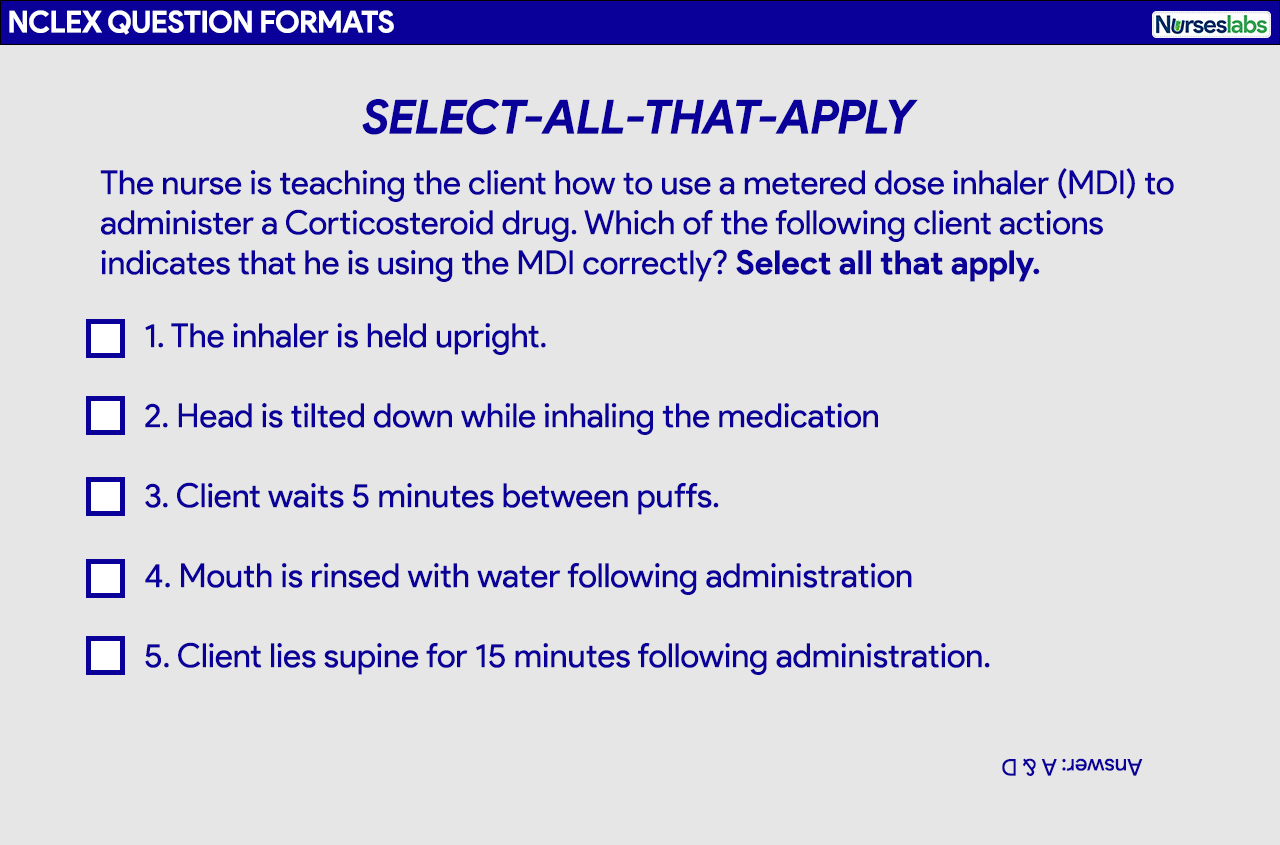
What is NCLEX: Content Areas Covered by the NCLEX
The NCLEX is comprehensive, assessing your competence across several key areas of nursing. Each content area is designed to evaluate your ability to provide safe and effective care in real-world scenarios.
1. Safe and Effective Care Environment
- Management of Care: Focuses on prioritization, delegation, and patient advocacy.
- Safety and Infection Control: Covers preventing hazards and maintaining sterile environments.
2. Health Promotion and Maintenance
- Includes topics like growth and development, pregnancy, newborn care, and preventive health measures.
3. Psychosocial Integrity
- Emphasizes mental health, coping mechanisms, and patient emotional support.
4. Physiological Integrity
The largest section, divided into:
- Basic Care and Comfort: Assessing skills like hygiene and pain management.
- Pharmacological and Parenteral Therapies: Medication administration and interactions.
- Reduction of Risk Potential: Identifying complications early.
- Physiological Adaptation: Managing acute and chronic conditions.
Is NCLEX is Offered on Holidays? Find out today by reading this article!
How the NCLEX Differs from Nursing School Exams: What is NCLEX?
Many candidates underestimate how different the NCLEX is compared to their nursing school exams. Here’s what sets it apart:
Application-Based Questions
- Unlike nursing school exams, which may focus on rote memorization, the NCLEX tests your ability to apply knowledge in real-life scenarios.
Broad Content Scope
- The NCLEX covers all areas of nursing practice, requiring you to be well-rounded in your preparation.
Adaptive Testing
- The CAT system ensures a tailored experience that challenges your decision-making abilities, unlike static nursing school tests.
Preparing for the NCLEX: First Steps
By now we have answered 70% of the question “what is the nclex exam?”. We move our focus to preparing for the exam ensuring we provide you with secret resources to use for your exam. Getting started with NCLEX preparation requires organization and focus. Here’s how to begin:
1. Understand the Test Plan
The NCSBN NCLEX Test Plan outlines the content areas and weightage. Familiarizing yourself with this document is crucial for targeted preparation.
2. Take a Diagnostic Test
- Start with a practice test to assess your baseline knowledge.
- Analyze the results to identify strengths and weaknesses.
3. Choose the Right Study Materials
Select resources that suit your learning style:
- Nclexreviewprep.com: Access the exact exam questions and answers for targeted preparation, get your license directly or upgrade your nclex score.
- Books like Saunders Comprehensive Review for the NCLEX-RN for content mastery.
- Platforms like UWorld for practice questions with detailed rationales.
- Apps like NCLEX Mastery for on-the-go study.
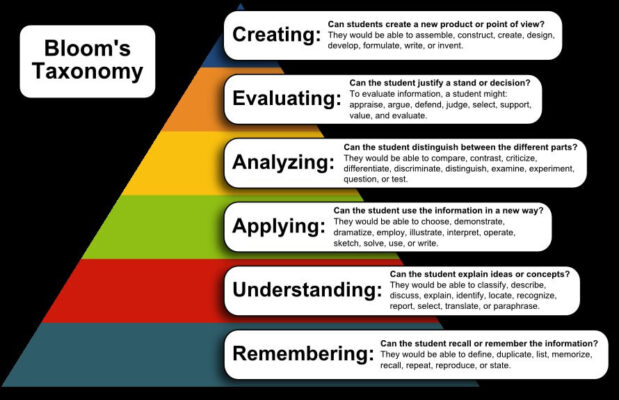
Mastering Test-Taking Strategies for the NCLEX
Knowing how to approach the NCLEX strategically is just as important as studying the content. Effective test-taking strategies can help you tackle even the most challenging questions with confidence.
Understanding the NCLEX Question Logic: What is the NCLEX Exam?
Analyzing the Question Stem
- Look for keywords such as priority, initial, most appropriate, or best. These words determine what the question is asking.
- Pay attention to negative qualifiers like except, not, or least likely, as they change the question’s focus.
Breaking Down the Answer Options
- Eliminate answers that are obviously incorrect.
- Consider each option carefully and rule out those that don’t align with the patient scenario.
- Choose the answer that ensures patient safety or adheres to nursing standards.
Prioritization Techniques: What is nclex?
Many NCLEX questions test your ability to prioritize care effectively. Use these frameworks to guide your answers:
Maslow’s Hierarchy of Needs
Prioritize interventions based on this hierarchy:
- Physiological Needs: Breathing, circulation, nutrition.
- Safety and Security: Protecting the patient from harm.
- Psychosocial Needs: Addressing emotional well-being.
ABCs (Airway, Breathing, Circulation)
In emergency scenarios, always address airway first, followed by breathing and circulation.
Comment: Include a flowchart comparing Maslow’s Hierarchy with the ABCs framework for NCLEX prioritization.
Alt text: Visual showing how Maslow’s Hierarchy and ABCs prioritize patient care.
Select-All-That-Apply (SATA) Questions
Why SATA Questions Are Challenging
- They require selecting multiple correct answers without partial credit.
- Each option must be evaluated independently as true or false.
How to Approach SATA Questions
- Read the question stem carefully and identify the focus.
- Evaluate each option as a standalone statement.
- Avoid overthinking—select only the options that clearly apply to the scenario.
Find out How Many Questions Are on the NCLEX? Everything You Need to Know
How the NCLEX is Scored
Understanding the NCLEX scoring system can alleviate anxiety and help you focus on what really matters during the exam.
The Role of Computerized Adaptive Testing (CAT)
How CAT Works
- The test begins with questions of medium difficulty.
- Based on your performance, the difficulty adjusts to challenge your ability level.
- The exam continues until the system determines, with 95% confidence, whether you meet the passing standard.
Why the Number of Questions Varies
- If you demonstrate competency early, the test may end after the minimum number of questions (75 for RN, 85 for PN).
- If the system needs more data, you may receive up to the maximum number of questions (145 for RN, 205 for PN).
Pass/Fail Criteria
The NCLEX is a pass/fail exam, meaning you won’t receive a numerical score. Instead:
- Pass: Indicates you met or exceeded the passing standard.
- Fail: Indicates areas where further improvement is needed.
Comment: Add an infographic explaining how CAT scoring determines pass/fail outcomes.
Alt text: Diagram of the NCLEX scoring process using Computerized Adaptive Testing.
Find out What Percentage Do You Need to Pass the NCLEX?
Quick Results and Official Results
- Many states offer unofficial results within 48 hours for a small fee.
- Official results, including your license, typically arrive within 2–4 weeks.
What to Bring on NCLEX Exam Day
Preparation doesn’t end with studying. Arriving prepared on exam day is equally important for staying focused.
Essential Items
- Photo Identification: Ensure your government-issued ID matches the name on your test registration.
- Authorization to Test (ATT): Print or save the email for quick access.
- Comfortable Clothing: Dress in layers, as testing centers may be cold or warm.
What NOT to Bring
- Electronic devices, including phones and smartwatches.
- Personal belongings such as bags, books, and water bottles (lockers may be provided).
- Notes or study materials, which are strictly prohibited.
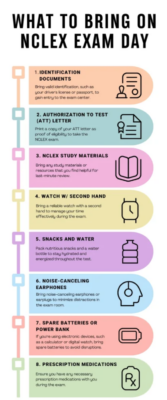
Managing Stress on Test Day: What is NCLEX
Test anxiety can significantly impact performance. Implement these strategies to stay calm and focused:
Before the Exam
- Deep Breathing Exercises: Take slow, deep breaths to calm your nerves.
- Positive Visualization: Picture yourself successfully answering questions and passing the exam.
During the Exam
- Pace Yourself: Avoid spending too much time on a single question.
- Use Breaks: Take scheduled breaks to reset your mind.
- Stay Positive: Replace negative thoughts with affirmations like, “I’ve prepared for this.”
Frequently Asked Questions About the NCLEX
Here are some common questions that candidates ask about the NCLEX:
How Long Should I Study for the NCLEX?
- Recommended Timeframe: Dedicate 6–8 weeks to preparation, with 4–6 hours of study daily.
How Many Times Can I Take the NCLEX?
- Candidates can take the NCLEX up to 8 times per year, with a mandatory 45-day waiting period between attempts.
Find out What Happens If You Fail the NCLEX?
What If I Run Out of Time During the Exam?
- The exam will automatically evaluate your performance based on the questions you answered.
- If the system determines you met the passing standard, you will pass even if time runs out.
Conclusion: Preparing for Success
The NCLEX is a challenging but conquerable exam. By understanding its format, mastering test-taking strategies, and preparing effectively, you’ll set yourself up for success. Remember, preparation is key, and confidence comes from knowing you’ve done the work. With that said, we should have successfully covered what nclex is, as well as answered the question “what is the nclex exam?”

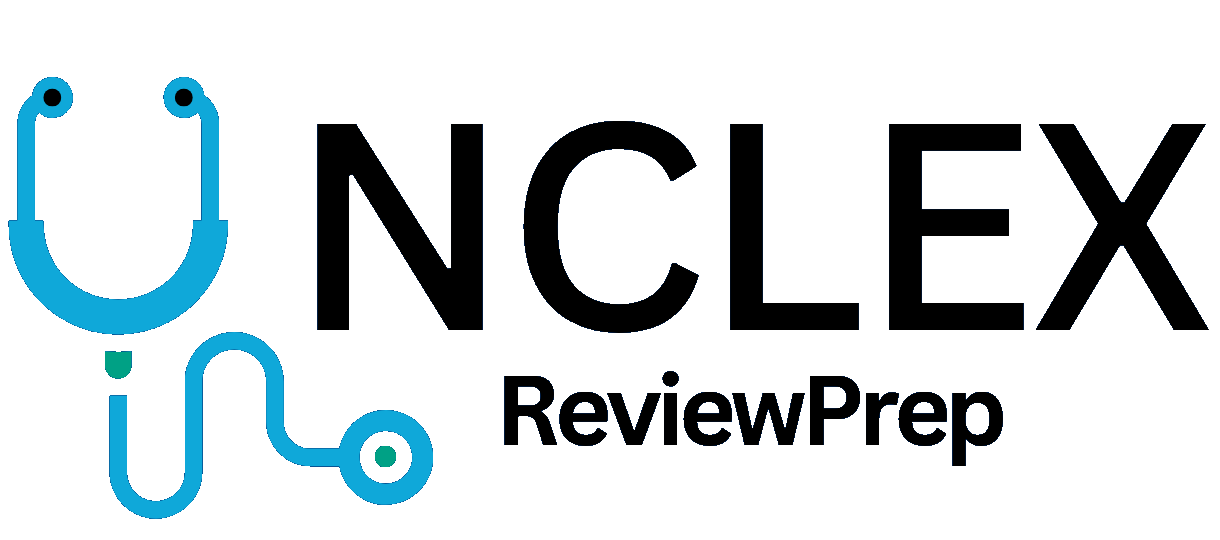
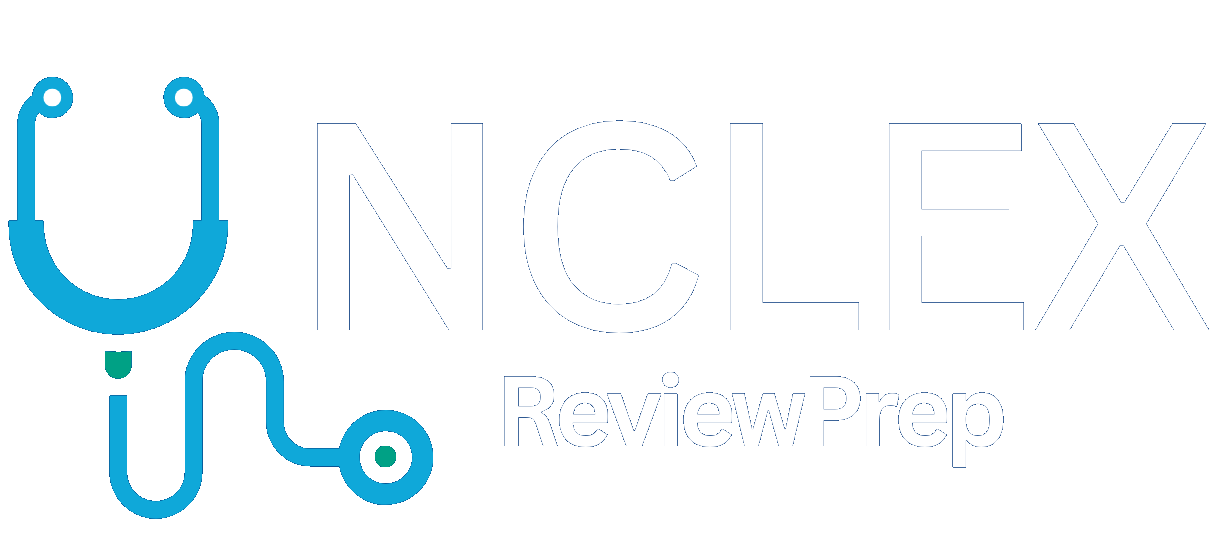
Pingback: How to Pass the NCLEX: Your Ultimate 2024 Guide to Success
Pingback: How Hard is the NCLEX Exam? Secrets to Overcome the Challenge - NCLEX Review Prep